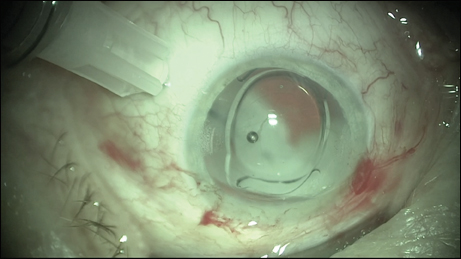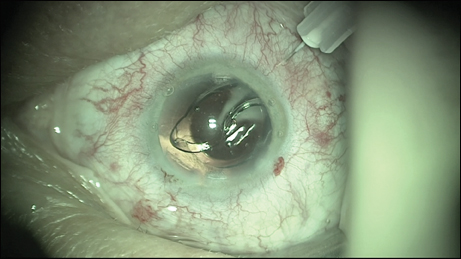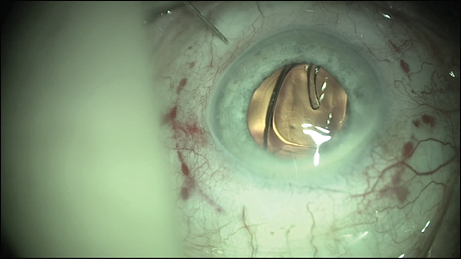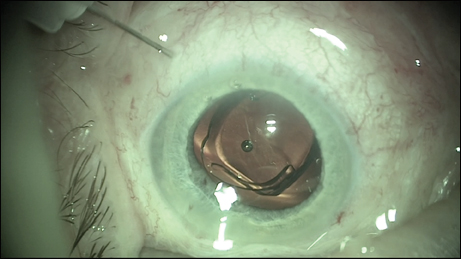Pars plana approach can be used for surgical injection technique
A surgeon explains why he prefers this approach over a transzonular one.
Topical ocular medications are an integral part of the pre- and postsurgical therapeutic regimen for cataract and other anterior segment procedures. The use of these mostly multi-dose topical medications introduces issues such as patient compliance, cumulative added drug cost to the patient, preservative-related alterations to the ocular surface and secondary visual quality degradation.
The introduction of the “dropless” approach to the surgical therapeutic regimen appears to be a welcome modality that negates many issues with drops. However, such a turn in the path of ocular drug delivery poses new challenges and has to meet the litmus test of therapeutic efficacy, safety and absence of any major drug-related complications. New therapeutic routes of drug delivery during cataract surgery include the anterior chamber, posterior chamber, pars plana region and vitreous. Such a route of drug administration has the added advantage of direct, timely treatment of potential pathogenic organisms that may contaminate the interior of the eye during cataract surgery.
There is a continued increase in the total number of U.S. ophthalmic surgeons utilizing the intracameral route of drug administration during cataract surgery. The two preparations of interest include Tri-Moxi, which consists of compounded triamcinolone acetonide and moxifloxacin hydrochloride, and Tri-Moxi-Vanc, which also has vancomycin (both Imprimis Pharmaceuticals). These sterile, compounded, preservative-free injectable preparations include two effective broad-spectrum antibiotics, moxifloxacin and vancomycin, combined with long-acting triamcinolone. Current administration techniques include transzonular using a 30-gauge cannula or a pars plana approach. To date there have been no cases of endophthalmitis reported in the literature with the use of these medications, and they seem to protect against cystoid macular edema and inflammation for most of the treated patients. In a small subset of patients, breakthrough inflammation may require supplemental topical treatment.
The time has come to seriously consider and possibly embrace these new directions in therapeutic drug delivery systems for the betterment of our patients’ cataract surgery experience, drug-related cost savings and overall patient satisfaction. However, continued vigilance and close monitoring of patients undergoing these newer therapeutic treatment modalities are essential for a firm establishment of safety and efficacy.
In this column, Dr. Atwal describes his method of using “dropless” cataract surgery for more than a year and his personal experience with this technique of drug delivery at the time of cataract surgery.
Thomas “TJ” John, MD
OSN Surgical Maneuvers Editor

Since August 2014, I have performed “dropless” cataract surgery on all of my cataract patients, regardless of type, be it laser cataract, traditional cataract, single vision or multifocal lens, exclusively using Tri-Moxi-Vanc. I perform more than 2,000 cataract surgeries a year, about 50% of which are laser cataract surgeries.
I currently do not use “dropless” on our patients who require cataract surgery and have endstage glaucoma that requires intervention. For our corneal transplant patients, the “dropless” formulation does not yet have the half-life to match the patient’s needs. Other types of surgical patients, though, receive “dropless” surgery, the cost of which we currently absorb. The benefits of going “dropless” to the patient, the surgeon and the clinic staff make the cost well worth it.
Pars plana vs. transzonular approach
While most surgeons prefer a transzonular approach, my predilection for utilizing a pars plana approach is twofold. First, I feel the transzonular approach can be technically more challenging for some doctors. Most modern surgeons are trained in administering intravitreal medications and are therefore already comfortable with this technique. Second, due to the inability to visualize zonules and the ciliary body with a transzonular approach, I prefer a pars plana approach.
The pars plana approach is faster as well. It does not require any special cannulas or learning experience. The reality is that any surgeon who has graduated from residency within the last 6 years has placed numerous pars plana injections and should find the application of this technique straightforward. Therefore, this approach seems much more sensible to me than going trans-zonular.




Images: Atwal ES






Surgical procedure
While I am performing the cataract surgery, my scrub tech pulls and primes 0.6 cc of Tri-Moxi-Vanc into a 1-cc syringe and places a 30-gauge needle on the syringe. I place my IOL in the capsule with viscoelastic. I then take the syringe with the Tri-Moxi-Vanc, place it 3.5 mm behind the limbus, insert the needle inferotemporally through the pars plana and slowly inject 0.2 cc of the Tri-Moxi-Vanc.
I then have the patient look down and inject the remaining 0.4 cc into the superior fornix sub-Tenon’s space. I take care to avoid all major conjunctival blood vessels with the needle. If the patient feels any pain during these injections, it is typically because the medication has been administered more subconjunctival than sub-Tenon’s. It is much more comfortable for the patient if it is sub-Tenon’s.
While injecting the medication into the superior fornix sub-Tenon’s space, I restrict the distribution of the medication with my balanced salt solution cannula so it stays hidden in an area that will be covered by the upper eyelid. This also allows me to manage more easily the hydration of the wound and ensure there is minimal ballooning around the perilimbal conjunctiva. Viscoelastic removal and wound hydration proceed as usual at this point.
Reduction in breakthrough inflammation
After starting the “dropless” regimen, I noted that approximately 10% of my patients were developing breakthrough inflammation at their 2-week visit. Implementing the use of drops to combat this issue was a possible solution. However, because the purpose of Tri-Moxi-Vanc as a surgical adjunct is to eliminate drops, and because our patients expect a “dropless” experience, I desired to commit to the “dropless” concept.
With triamcinolone injections, medication placed in sub-Tenon’s maintains an extended intraocular half-life and acts as a depot for medication in the vitreous. Studies show sub-Tenon’s triamcinolone has an effect in the vitreous 28 days after injection. I decided to apply this technique and place the medication in the vitreous as well as sub-Tenon’s and utilize the potentiating effect of having medication in two anatomic locations within the eye.
Since employing this procedure, there has been a noticeable decrease of approximately two-thirds of our previous cases of inflammation. There will always be some cases of breakthrough inflammation, but the number is significantly fewer than previously noted. For those cases that do occur, they are treated accordingly. In general, I will add a topical steroid or NSAID.
Pars plana injections are something that every ophthalmologist, regardless of subspecialty, should be able to do. While it can be daunting for those less familiar with them, I would encourage surgeons not to be afraid of it. Get a caliper out, measure 3.5 mm, insert the needle and inject in the direction of the nerve. Of course, the best option is whatever you are most comfortable with, but the advantages of the pars plana approach make it the obvious choice for me.
- References:
- Braga-Mele R, et al. J Cataract Refract Surg. 2014;doi:10.1016/j.jcrs.2014.10.010.
- Cleary CA, et al. J Cataract Refract Surg. 2010;doi:10.1016/j.jcrs.2010.04.038.
- Espiritu CR, et al. J Cataract Refract Surg. 2007;doi:10.1016/j.jcrs.2006.09.019.
- Karalezli A, et al. Acta Ophthalmol. 2008;doi:10.1111/j.1600-0420.2007.01114.x.
- Lane SS, et al. J Cataract Refract Surg. 2008;doi:10.1016/j.jcrs.2008.05.034.
- Park HJ, et al. Retina. 2014;doi:10.1097/IAE.0000000000000000.
- Takata C, et al. Retina. 2010;doi:10.1097/IAE.0b013e3181c969b4.
- For more information:
- Ephraim Singh Atwal, MD, the director of the Atwal Laser Vision Correction and Aesthetic facility, can be reached at 3095 Harlem Road, Cheektowaga, NY 14225; email: dratwal@gmail.com.
- Edited by Thomas “TJ” John, MD, a clinical associate professor at Loyola University at Chicago and in private practice in Oak Brook, Tinley Park and Oak Lawn, Ill. He can be reached at tjcornea@gmail.com.
Disclosure: Atwal and John report no relevant financial disclosures.
